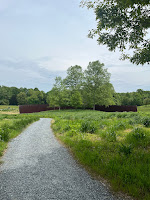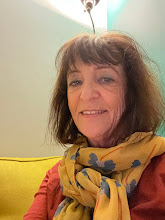Two major exhibitions recently opened, ending the year on a high note: Mark Rothko a retrospective at the Fondation Louis Vuitton in Paris and Mark Rothko: Paintings on Paper at the National Gallery of Art in Washington, D.C. Both organized in chronological order gather more than one hundred paintings each, some of them rarely seen, selected from renown institutions like the The Phillips Collection, the National Gallery of Art or the Tate, and from private collections. Since my memorable encounter with the artist's work at the Museum of Fine Arts Houston in 2015, I thought Rothko had no secrets for me. My peregrinations allowed me to visit both shows which left me dazzled by the richness of their content.
Starting in Paris, I was struck by a self-portrait made in 1936 near the entrance. The thirty-three-year-old artist, somber and enigmatic, eyes hidden behind dark glasses, appears to scrutinize the viewer. Other than this unsettling painting, Rothko's portraits are forgettable as confirmed a few weeks later looking at his works on paper. The figurative urban scenes of the 30's are followed by the often ignored paintings from the early 40's, foundations of his practice. In search of a universal "new myth" he incorporates motives from Greek mythology, then moves to surrealistic dreamscapes as he slowly veers to abstraction with his "Multiforms" until shapes become simple colored blocks floating on limitless monochrome backgrounds filling vertical canvasses. Rothko's practice reaches its acme in the 50's and the display of such a great number of works from the period is enthralling. Being surrounded by the paintings radiating in the semi-darkness is a unique experience. Each of them stirs deep emotions through a gamut of moody blues, elating yellows, oranges, reds, a symphony of colors mostly joyous until we reach the display of darker paintings introducing black, wine color, and a room filled with the Seagram Murals travelling from the Tate Modern in London, followed by several "Blackforms". Rothko's attempt to make black glow in the dark to let paintings "generate their own light", a rehearsal for the Rothko Chapel at The Menil Collection, engenders the same feeling of gloom and doom that besets me following my visits at the chapel itself in Houston. Braving a line of visitors, I spent a few minutes in the small gallery in which the Rothko Room from The Phillips Collection is recreated minus one painting. As a frequent visitor of the venue in D.C., I have been able to contemplate the paintings in total serenity time and again. On the highest floor, a unique display assembles iconic sculptures from Giacometti and Rothko's late acrylic paintings (1969-1970) from the Black and Grey series, highlighting the influence of Giacometti's works on the painter. I could not recall seeing these before, but if I had, the uninspired grayish masses under flat black rectangles did not catch my attention. As a final note, three vibrant paintings made in 1967 in the small adjacent gallery remind us that Rothko never renounced the use of colors in his practice.
Back in Washington, I could not miss the exhibition at the National Gallery even as I thought it might be redundant or worse, disappointing. It was full of surprises. With about a dozen paintings per room, the show unfolds in the same chronological order starting with figurative landscapes, portraits and nudes, providing a glimpse in the nascent artist's career. The wall texts add moving details about Rothko's life and the poor response to his works at the time. The next two rooms are a journey into the artist's surrealist period through a succession of paintings from the mid-40's I had never seen before. Each of them tells a story born from deep connections to mythology, prehistory, a primal world in which the artist searches for a new myth to reach spirituality. I spent some time looking at the biomorphic shapes floating in soft watery colors, savoring their content and the delicate brush strokes. Slowly, the paintings undergo some kind of purification as they become more abstract and the next works mirror those on canvas from the 50's, although smaller in size precluding a total immersion in the landscapes of colors. As we progress, the tones get darker and on the next floor, we reach the Brown and Grays series on paper echoing the Black and Grey series on canvas. Nearby, black paintings slowly appear to glow revealing drips of luminescent paint. The effect is working this time, possibly due to a careful lighting? Close by, in a separate space, a life size photograph of Rothko walking toward a huge easel gives a concrete idea of the painter's physical labor, and a few unfinished paintings on paper reveal Rothko's technique. Moving on, the last room is another delightful surprise, "an ethereal suite of paintings on paper with soft, cloudlike edges surrounded by margins of pale paper". The wall text gives a perfect description of the paintings, evoking the soft colors of the surrealist period. These late works, contemporary to his Brown and Grays series, close the show on a ravishing note.
"Why paint at all?" The answer is found in these two landmark exhibitions giving an in depth look at the path of Rothko's practice, reflection of his inner and most private life. The artist, a master of colors did not want to be called a colorist. Painting for him is not about beautiful hues, but is a catharsis in his search for the spiritual and his interest in "expressing basic human emotions". We can participate to the artist's journey as he arises a primitive angst common to all of us and translates the unspeakable through his art. A quote from Robert Rosenblum about the abstract sublime seems very appropriate: "These infinite, glowing voids carry us beyond reason to the Sublime; we can only submit to them in an act of faith and let ourselves be absorbed into their radiant depths."
Rothko was concerned about his legacy: "A painting lives by companionship, expending and quickening in the eyes of the sensitive observer. It dies by the same token." The unavoidable crowd of selfie takers somewhat spoils the visit, and the images of Rothko's paintings on the phone screens do not allow to "look and see". Everyone recognizes "a Rothko" and moves on.
Just a reminder that we are responsible for the artist's legacy as the two exhibitions resonate well beyond the visit.



























